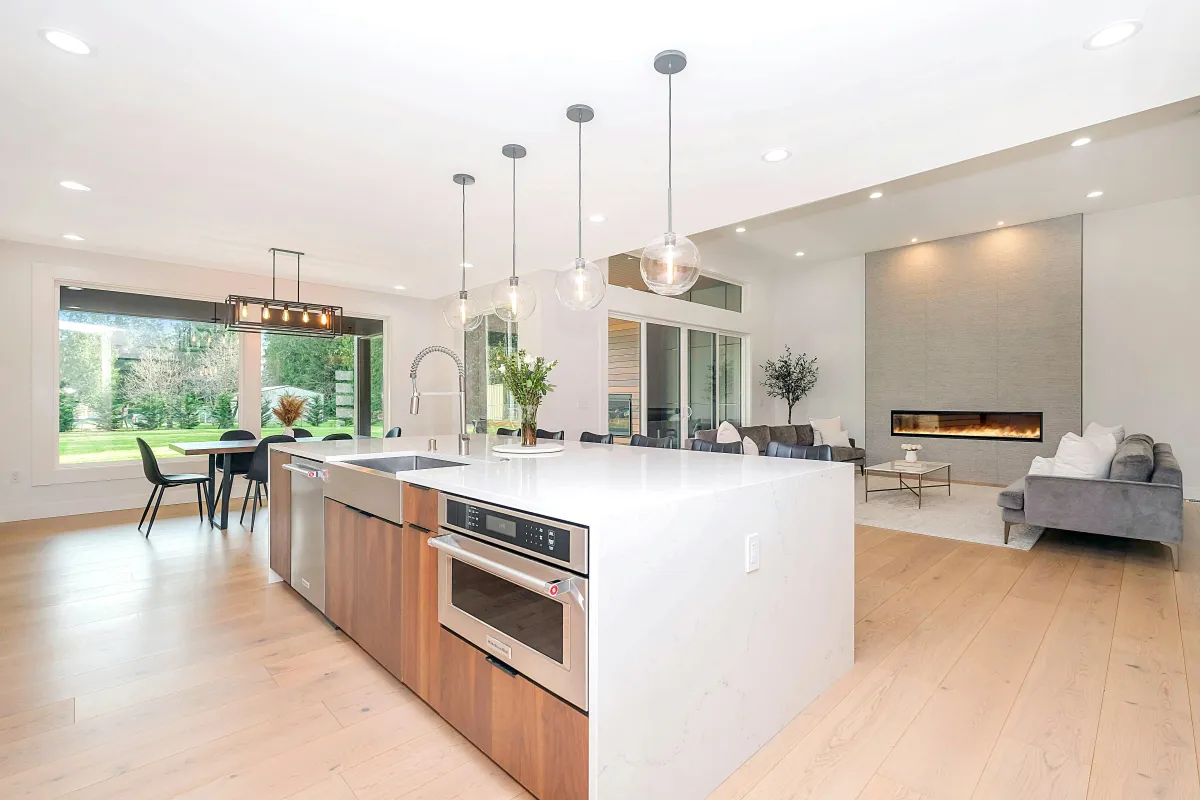
Versatile Custom Home Floor Plan Options for Modern Living
Building a custom home is a deeply personal journey that begins with a well-designed floor plan. The layout you choose defines how your family will live, move, and connect within the space. From everyday routines to long-term goals, every room should reflect comfort, efficiency, and individual style. Whether you’re planning for a growing household, remote work needs, or sustainable living, the right floor plan brings your vision to life. This guide explores popular layouts, customization options, architectural influences, and smart design choices to help shape your ideal home.
Key Takeaways
Custom home floor plans ensure a space is both functional and reflective of the owner’s style.
Options like ranch, two-story, bungalow, and modern designs suit various lifestyles.
Architectural styles and sustainable features impact design, cost, and energy efficiency.
Room-specific layouts, including kitchens, bedrooms, living areas, and bathrooms, optimize utility.
Choosing a builder involves assessing expertise, sustainable experience, and client testimonials.
What Are the Most Popular Custom Home Floor Plan Types?

Choosing the right floor plan shapes how your home looks, feels, and functions. Popular custom layouts include designs like ranch, two-story, bungalow, and modern open-concept homes. Each option caters to different household needs, from spacious family living to compact efficiency. These plans influence how rooms connect and how daily life flows. Selecting a suitable plan can balance beauty, practicality, and long-term comfort.
What Defines Ranch-Style Floor Plans and Their Benefits?
Ranch-style floor plans are single-level layouts that promote seamless indoor-outdoor living. These designs often connect living, dining, and kitchen areas in an open format. Large windows and sliding glass doors enhance natural lighting and outdoor access. Their layout supports mobility and ease of navigation, making them ideal for varied household needs. The simplified structure helps lower energy consumption and reduces long-term maintenance. These homes emphasize practicality while still allowing personalization. With fewer stairs and straightforward organization, they offer ease of living. Ranch-style homes blend simplicity with functionality in a highly efficient footprint.
How Do Two-Story Floor Plans Maximize Space and Functionality?
Two-story floor plans divide public and private spaces vertically, increasing usable square footage. Living and social areas are placed on the lower level, while bedrooms and quiet zones are situated above. This separation provides acoustic privacy and efficient space allocation. High ceilings, staircases, and open landings create visual interest. The vertical expansion allows for more yard space on smaller plots. These homes accommodate diverse household activities without sacrificing privacy. The layout supports flexible room assignments like offices or guest suites. Two-story homes cater well to growing families seeking spatial variety.
What Makes Bungalow Floor Plans Ideal for Cozy Living?
Bungalows provide compact yet functional single-story living spaces with warm, accessible layouts. They often include small additions like lofts or reading nooks to expand usability. Built-in storage solutions make the most of available space while reducing clutter. Their porches and garden-friendly orientation foster indoor-outdoor integration. These homes are ideal for those seeking comfort and efficiency in a smaller footprint. A cozy design promotes energy savings and ease of maintenance. Bungalows are especially suited for individuals or small families. Their thoughtful arrangement supports everyday living with charming simplicity.
Why Choose Modern Floor Plans With Open Concepts?
Modern open-concept floor plans eliminate barriers between rooms, promoting flow and visibility. These layouts feature expansive spaces filled with natural light from large windows and skylights. High ceilings and clean lines support a minimalist, adaptable lifestyle. Spaces like kitchens, dining, and living areas merge for better social interaction. These designs integrate indoor-outdoor connections with direct patio access. The layout supports energy savings by maximizing daylight and minimizing artificial lighting. Simplified maintenance and modern styling appeal to many homeowners. Open-concept homes reflect contemporary living with sleek, efficient design.
How Can Floor Plans Be Tailored to Different Lifestyles?

Custom floor plans allow homeowners to match their living spaces with their day-to-day routines. Whether it's a growing family, a couple downsizing, or professionals working from home, layout flexibility is key. The ability to adapt rooms to lifestyle changes adds long-term value. Thoughtful design ensures comfort, efficiency, and harmony in every corner. Personalizing a floor plan helps create a home that truly fits.
What Features Make Family-Friendly Floor Plans Practical?
Family-friendly layouts prioritize safe, spacious environments for shared living. Open areas with zones for dining, play, and homework allow easy supervision and flexibility. Durable surfaces, built-in storage, and child-accessible features enhance usability. These homes often include direct access to fenced yards or patios for outdoor activity. Bedrooms are positioned to support rest while maintaining proximity to communal spaces. Natural light and airflow are emphasized for comfort and energy efficiency. These layouts balance togetherness with areas for quiet retreat. Practical design ensures the space evolves with the family’s needs.
How Are Empty Nester Home Designs Optimized for Comfort?
Empty nester homes are tailored for simplicity, comfort, and ease of upkeep. They often feature spacious master suites and reduced overall square footage. Open living areas support socializing without excess maintenance. Outdoor zones like patios or sunrooms enhance leisure time. These layouts frequently include flexible rooms for hobbies or occasional guests. Energy-efficient appliances and centralized features reduce utility and upkeep demands. Storage is designed to be accessible without overwhelming. The overall feel prioritizes relaxed living with thoughtful, streamlined spaces.
What Are the Best Home Office Layouts for Remote Work?
Effective home office layouts create separation without isolating workspaces from daily life. Ideal setups are located near natural light and offer quiet, low-traffic areas. Designs integrate ergonomic features and smart tech connectivity. Storage solutions help maintain organization and focus. Open shelving, built-in desks, or dedicated nooks support productivity. Acoustic separation helps minimize distractions during work hours. The office can flex as a guest room or creative studio when needed. Remote-friendly layouts blend professionalism with home comfort.
How Do Multi-Generational Home Plans Accommodate Everyone?
Multi-generational homes incorporate both shared and private zones to balance needs. Designs include separate suites or entrances for independent living. Additional bathrooms and flexible bedrooms support privacy. Open kitchens and family areas encourage interaction and communal meals. Insulated walls and zoning help maintain noise control and comfort. Common areas are spacious and adaptable for events or daily use. Storage and utility rooms are expanded for shared convenience. These layouts prioritize comfort while respecting personal space across generations.
Which Architectural Styles Influence Custom Home Floor Plans?

Architectural styles help shape both the look and functionality of a custom home. From minimalist to rustic designs, these influences guide everything from room layout to material selection. Aesthetic choices often reflect lifestyle priorities—simplicity, tradition, innovation, or warmth. Each style brings its own advantages for comfort, efficiency, and visual appeal. Aligning design preferences with a fitting architectural style ensures the home feels cohesive and inviting.
What Are the Key Elements of Modern Home Design?
Modern home designs emphasize streamlined, spacious interiors with clean lines and smart features. Expansive windows and skylights support natural lighting and visual flow. Neutral palettes and simple finishes encourage calm, uncluttered living. These plans often include built-in storage and open layouts for flexibility. Materials are selected for sustainability and low environmental impact. Integration of energy-saving systems is common. Minimalism helps reduce unnecessary features while highlighting essential functions. The result is a functional yet refined living space.
How Does Craftsman Style Shape Floor Plan Layouts?
Craftsman-style homes highlight handcrafted elements and strong indoor-outdoor harmony. Floor plans often include large porches and central fireplaces. Interiors emphasize built-in shelving, seating, and exposed woodwork. Room transitions are smooth, maintaining warmth and flow. Materials like wood and stone create natural aesthetics. Wide eaves and carefully positioned windows enhance comfort and efficiency. These designs focus on structural detail and durability. Craftsman homes feel inviting, grounded, and built to last.
What Defines Farmhouse Home Design and Its Floor Plans?
Farmhouse floor plans offer practical layouts with rustic charm and modern adaptability. Common features include large front porches and open family areas. These homes emphasize straightforward room arrangements and communal living. Natural materials like wood and metal enhance warmth and simplicity. Flexible layouts support large gatherings and functional zones. Kitchens are often central and highly accessible. The design supports easy flow and long-term usability. Farmhouse homes balance timeless style with efficient everyday living.
How Does Contemporary Design Affect Floor Plan Choices?
Contemporary homes evolve with current needs, blending design innovation with function. Layouts avoid rigid divisions and emphasize multipurpose areas. High ceilings, open kitchens, and shared workspaces are common. Materials are selected for environmental and visual harmony. Smart systems streamline temperature, lighting, and security. Modular designs support future lifestyle changes. Flexibility is built into every space. These homes reflect ongoing shifts in how people live and interact.
How Do Sustainable Features Enhance Custom Home Floor Plans?

Sustainable features are essential for building efficient, eco-conscious homes that reduce long-term costs. By integrating energy-saving systems, durable materials, and smart technologies, homeowners can enjoy both comfort and conservation. These elements shape how the home functions daily, influencing layout, airflow, and material use. A sustainable approach also ensures the home meets modern building standards. Custom floor plans with eco-friendly features provide lasting value and healthier living.
What Are the Benefits of Energy-Efficient Home Designs?
Energy-efficient homes reduce long-term costs through smart insulation and systems. Thoughtful building orientation takes advantage of sunlight and shade. Features like solar panels and efficient HVAC systems support sustainability. Materials are chosen for performance and environmental impact. Layouts are designed to minimize energy loss through strategic room placement. These homes also prioritize air quality and comfort. Lower utility bills and fewer emissions are key benefits. Efficiency enhances lifestyle and property value.
Which Eco-Friendly Materials Are Common in Custom Homes?
Eco-friendly materials balance aesthetics with environmental responsibility. Reclaimed wood offers character and sustainability. Bamboo flooring and recycled steel provide durability. Low-emission concrete reduces construction impact. Natural finishes and nontoxic paints improve indoor air. These materials meet modern codes and green building standards. They support healthy environments without sacrificing design. Eco-conscious choices result in beautiful, long-lasting homes.
How Does Smart Home Technology Integrate With Floor Plans?
Smart technology enhances function by automating key home systems. Floor plans now include infrastructure for connectivity and sensors. Lighting, security, and temperature adjust automatically based on activity. Voice controls and mobile apps improve access and usability. Energy efficiency improves with real-time monitoring. Open layouts support smooth distribution of technology. These homes offer safety, convenience, and modern comfort. Integration is seamless from room to room.
What Green Building Certifications Should Homeowners Consider?
Certifications validate sustainability and performance in custom homes. Standards like ENERGY STAR and LEED measure energy use and materials. Homes built to these guidelines enjoy lower operating costs. Features are tested for environmental impact and efficiency. Certification ensures that the floor plan meets best practices. It also enhances property value and buyer confidence. Homeowners benefit from transparency and lasting savings. These benchmarks reflect smart, future-ready design.
What Room-Specific Designs Improve Custom Home Floor Plans?

A custom home isn’t just about the overall layout—it’s about optimizing every room for purpose, comfort, and style. Thoughtful room-specific designs improve how a space is used and how it connects to the rest of the home. Each area should reflect functionality without compromising aesthetics. From kitchens to bedrooms, every space plays a unique role. Careful planning ensures balance, efficiency, and a sense of flow throughout the house.
How to Design a Functional and Stylish Kitchen Layout?
Functional kitchens combine accessibility, storage, and social potential. Layouts link cooking, dining, and entertaining areas. Work zones are placed for smooth movement and flow. Features like islands and breakfast bars add flexibility. Smart appliances and lighting boost efficiency. Custom pantry designs improve organization. Flooring and surfaces are chosen for ease of cleaning. The kitchen becomes both a centerpiece and a workspace.
What Are the Best Bedroom Layouts for Comfort and Privacy?
Bedroom layouts prioritize tranquility and efficient use of space. Rooms are positioned for reduced noise and enhanced privacy. Natural light and soft finishes create restful atmospheres. En-suite bathrooms and walk-in closets are common. Reading corners and desk spaces add function. Lighting and window placement are planned for flexibility. Heating and cooling systems are optimized for comfort. Bedrooms serve as personalized retreats within the home.
How Can Living Room Designs Enhance Family Interaction?
Living rooms foster connection through open and adaptable layouts. Central seating encourages conversation and relaxation. Flow to dining areas and patios increases usability. Media centers, fireplaces, and accent walls add focus. Modular furniture supports changing needs. Lighting schemes highlight activity zones. Doors and windows link the space to outdoor views. These rooms bring people together and enhance daily living.
What Bathroom Features Optimize Space and Luxury?
Modern bathrooms blend elegance with everyday practicality. Walk-in showers and freestanding tubs add visual impact. Vanities with integrated storage reduce clutter. Natural materials create a calming, spa-like feel. Fixtures are chosen for efficiency and style. Layouts prioritize comfort and ease of movement. Lighting enhances both ambiance and function. Every detail supports comfort and cleanliness.
Frequently Asked Questions
How do I determine which floor plan type is best for my family?
Start by considering your household’s daily habits, number of residents, and any accessibility preferences or future needs. Whether you're drawn to the openness of a modern layout, the convenience of a single-story ranch, or the charm of a bungalow, selecting the right floor plan should reflect how your family lives. Custom Builder Connection can help by connecting you with vetted local builders and design professionals who evaluate your lifestyle and suggest suitable layout options tailored to your goals.
What are the primary benefits of integrating sustainable features into my home design?
Incorporating sustainable features helps reduce energy bills, improve indoor comfort, and support environmental responsibility. Energy-efficient HVAC systems, eco-friendly insulation, and smart automation tools are examples of features that add long-term value.
Are modern open concept designs more expensive than traditional layouts?
Modern open-concept homes may involve slightly higher upfront costs due to structural changes, larger windows, and integrated materials. However, the long-term advantages include better airflow, increased natural light, energy efficiency, and flexible spaces that grow with your needs.
How can I ensure that my custom home builder understands my lifestyle needs?
To make sure your builder aligns with your vision, start with a clear discussion of your daily routines, space requirements, and future plans. Share any must-have features like home offices, guest rooms, or aging-in-place options.
Conclusion
Custom home floor plans lay the foundation for a lifestyle where comfort, functionality, and energy efficiency converge. Whether you prefer a ranch, bungalow, modern open concept, or multi-level design, your floor plan can be tailored to meet family needs, work demands, and sustainability goals. Architectural styles—from modern minimalism to rustic farmhouse charm—further shape both the look and efficiency of your home. Partnering with an experienced custom home builder known for sustainable practices ensures that your blueprint, from the foundation to the roof and every ceiling and wall in between, reflects quality, efficiency, and lasting value.


